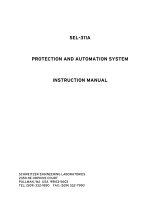
Specifications:
Polar pattern: cardioid
Frequency response: 50 to 17,000 Hz
Impedance: CM-311A: 75 ohms balanced
CM-311AE: 6 kohms unbalanced
Equivalent noise level: 26 dB-A
Maximum SPL: 148 dB
Powering: 18 to 48 V phantom power to DIN/IEC
Cable: 106 cm (42 in.)
Finish: satin black
Net weight: Head-worn mic, 61g (2.1 oz). CM-311A belt
back and battery, 173g (6.1 oz)
Item number: CM-311A 6000H50180
CM-311 AE 6000H50190
Boundary Layer Microphones
How to adjust for best fit and to prevent boom bounce
Note: To get the maximum performance out of this microphone, take the time to adjust it to
fit correctly.
For best results, the CM-311A MUST be custom fitted to a single user’s head. This simple
procedure takes only a few minutes.
1. If the microphone is for yourself, we suggest that you use a mirror to double check the fit
as you make adjustments.
2. Loosen (just a little) the thumbscrew located on the outside of the foam block, part way
back on the boom. This allows the boom to slide in and out, and to rotate left and right.
3. Now bend the headband wire to fit your head. Put the foam-block wire behind your ear.
Then you can bend the earpieces to fit snugly around your ears. The back of the headband
should fit firmly against the back of your neck.
4. Next, adjust the foam pad snug against your head or neck. To do this, bend the wire that
goes into the foam block. CAUTION! Do not bend the boom itself— just the foam-block
wire. A snug fit of the foam pad prevents boom bounce when you move around.
5. Be sure that the thumbscrew is still loosened a little. Move the boom in or out, and left or
right, to center the mic directly in front of your lips. The foam pop filter should press firmly
against the lips. This is necessary because the mic cancels sounds that are not close to it.
Also, it keeps the boom from bouncing. Tighten the thumbscrew and you’re done. Once
you’ve adjusted the headset, it should remain in that position -- no further adjustments are
needed. You can still swing the mic up or down, away from your lips, if you don’t want to be
heard on the P.A.
Architects` and Engineers’ Specifications
The microphone shall be the Crown Model CM-311Aor CM-311AE or equivalent.
The microphone shall be a head-worn, noise-cancelling, cardioid type of electret-condenser
design. The microphone shall exhibit excellent off-axis response and gain-before-feedback.
The microphone shall have an adjustable headband, adjustable boom with locking thumb-
screw, and foam pop filter. Model CM-311A shall include a battery belt pack. Model CM-
311AE shall be the head-worn micro-connect the microphone to the belt pack. The belt pack
shall include a 3-pin pro audio (XLR type) connector. In the CM-311AE, a 42-inch,
permanently attached, two-conductor shielded cable can be connected to a transmitter.
Model CM-311A shall be powered by a 9V battery in the belt pack, or by 18 to 48V phantom
power. The belt pack shall have a battery on/off switch, a programmable mic on/off switch,
and a “Mic On” LED. Model CM-311AE shall be powered by 3–9V DC from a transmitter.
Nominal open-circuit sensitivity shall be 4 or 1.25 mV/Pa. Maximum SPL shall be 148 dB SPL
for 3% THD. Equivalent noise shall be 27 dBA nominal. Frequency response shall be 50 Hz to
17,000 Hz with a uniform off-axis response, over 20 dB down at the rear null.
The Crown models CM-311A and CM-311AE are specified.




